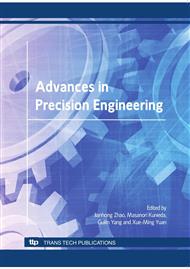p.282
p.287
p.292
p.297
p.301
p.306
p.316
p.321
p.326
Towards Smart and Competitive Sustainable Machining
Abstract:
Computer Numeric Control (CNC) revolutionized the machining technology and has been the cutting edge of digital manufacturing since 1950s. CNC machining model, simulation, verification, and optimization have been a vivid research topic of Smart Machining that automated the CNC programming (CAM) and cutting process, hence greatly increased machining productivity since 1990s. This paper traces back the history of CNC simulation, analysis the different CNC machining models, tested with application examples, and listed different CNC verification industry applications for the last 20 years. The new challenge comes from sustainable manufacturing. Towards smart and competitive sustainable machining, CNC model and simulation will be used to optimize the machining process, where the raw material could be saved through First Part Correct technology, the energy could be saved through cutting speed optimization, and used parts could be saved by remanufacturing.
Info:
Periodical:
Pages:
301-305
Citation:
Online since:
September 2010
Authors:
Keywords:
Price:
Сopyright:
© 2010 Trans Tech Publications Ltd. All Rights Reserved
Share:
Citation:


